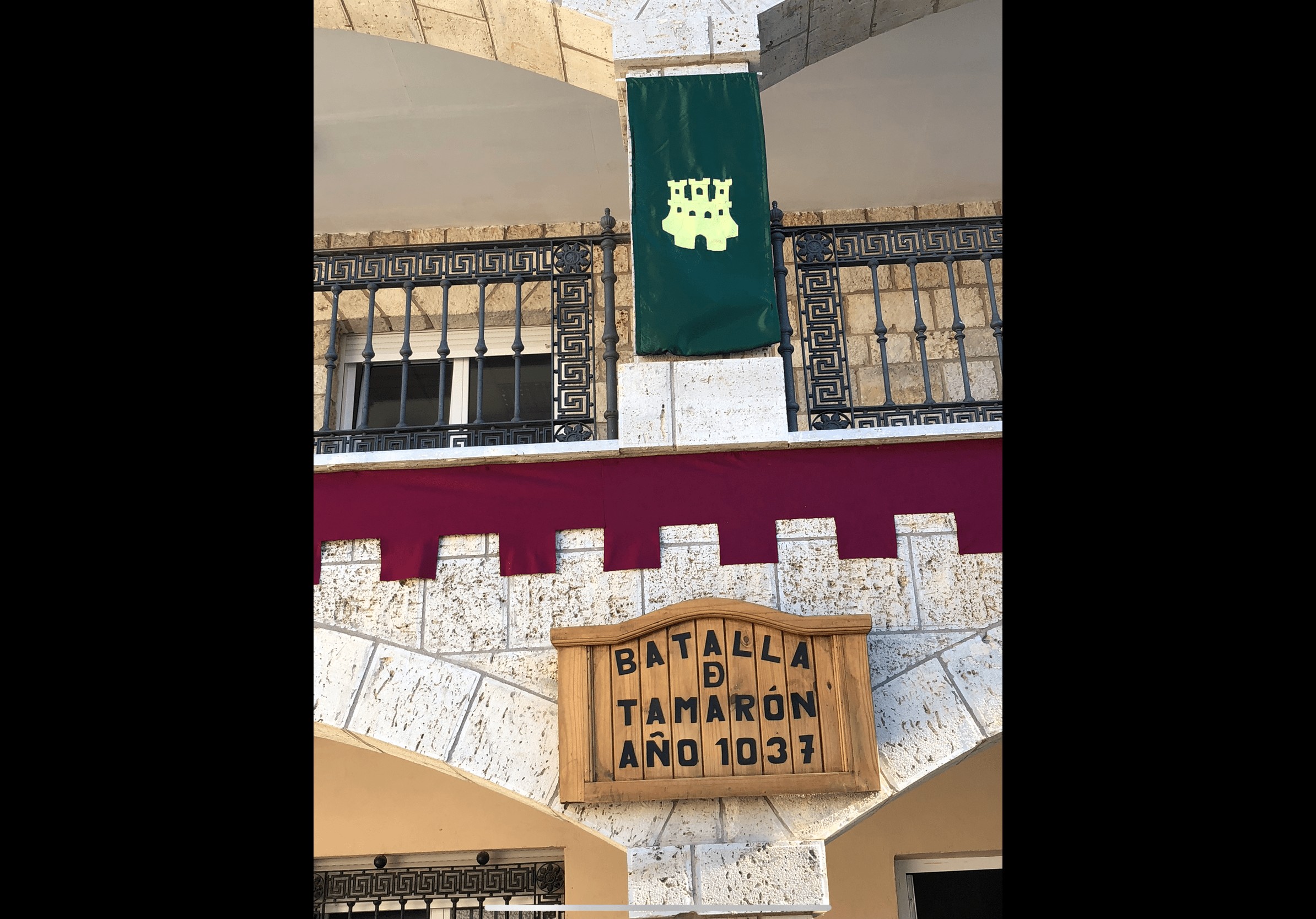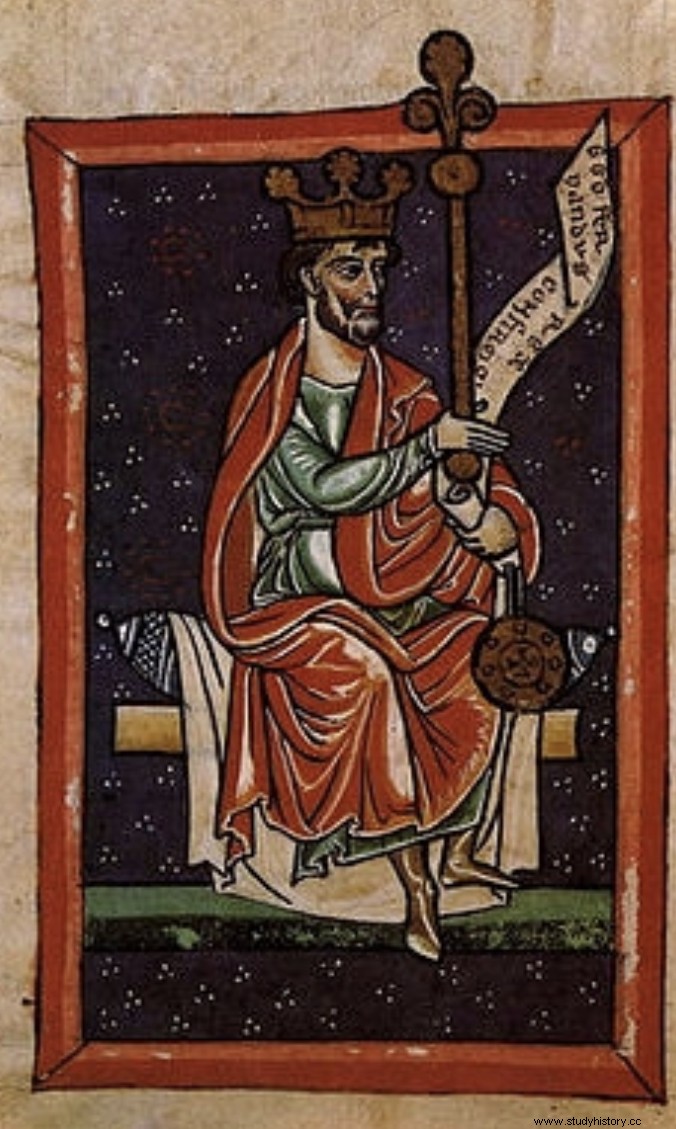Entry taken from the books "From Covadonga to Tamarón" and "From war to unification".

The case of Fernando I de León is a paradigmatic example of the interrelationship between the peninsular medieval kingdoms and domains. Born as an infant of the kingdom of Pamplona, he served as count of Castile and ended his days as king of León, dividing his domain among his three sons and placing a crown on the head of each of them.
Fernando was the son of King Sancho III the Elder of Pamplona, one of the most powerful monarchs of the Middle Ages on the peninsula, as evidenced by the extent of the territory inherited by his sons:García III was given the kingdom of Pamplona, Ramiro the Aragón county, to Gonzalo the counties of Sobrarbe and Ribagorza. And as for our protagonist Fernando, already in his lifetime he had been assigned title to the county of Castile, after the last descendant of Fernán González, Count García Sánchez, was assassinated in 1028 without leaving any descendants.
The sister of the murdered count, Mayor (or Munia) of Castile, was married to Sancho III el Mayor, and the county passed nominally to their son, Fernando Sánchez, although initially it was his father who exercised power in a county, the Castilian , which we must remember was still part of the kingdom of León, from which it never became independent.
When Sancho III died in 1035, his inheritance produced disagreements between the kingdoms of León and Pamplona, which ended in a confrontation on the battlefield between, on the one hand, Vermudo III of León and, on the other, the García III brothers of Pamplona. and Fernando count of Castile. This battle took place in Tamarón (Burgos) in 1037, and as a consequence of it Vermudo III died.

Commemoration of the battle of Tamarón in the town of the same name.
Vermudo III had no offspring. As for Fernando, his rights to the Leonese throne passed through those of his wife, Sancha, sister of Vermudo III, and it was not easy for the Leonese to recognize him as king. In fact he was not crowned in León until June 1038, almost a year after Tamarón and in that period he had to face and negotiate with the main Leonese noble families. But he finally managed to wear the crown of Leon.
In the following years, the alliance between the already King Fernando I of León and his brother García III of Pamplona turned into a confrontation. Both had spent years in continuous disputes over the border area of Castile. In addition, García's performance in the territory of the county of Castile that had corresponded to him by inheritance from Sancho III generated discomfort against him in the Castilian nobility, since in the distribution of the holdings of this territory he favored the Pamplona magnates to the detriment of the local nobility.
The situation worsened when two very similar incidents took place. When García fell ill, his brother, Fernando, went to Pamplona to visit him; There were several altercations and an attempt to take prisoner both the king and the queen of León, who had to flee Pamplona in a hurry. Later, it was Fernando who fell ill and García who went to visit León (some affirm that with the hope that he would die and appropriate his kingdom, although there is no record of this); in León, García was imprisoned and remained in prison for several days, but managed to escape.
From that moment on, the tension between the two kingdoms grew and border raids became general. Finally, after a frustrated mediation attempt by Domingo de Silos and Abbot Íñigo de Oña, the brothers decided to put an end to their disagreements in the countryside. of battle. The chosen place was Atapuerca, in Burgos, and the result of the battle favored the King of León. Garcia lost his life in the fight. In the same place, his son Sancho Garcés IV was proclaimed king, who had the blessing of the Leonese king and his uncle, Fernando, who, according to the chronicles, wept over the body of his brother and transferred it to the monastery of Santa María la Real. of Nájera, where he rests today.

Fernando I de León cries over the body of his brother García III de Pamplona in the representation of the battle of Atapuerca that takes place every year in that town.
During the rest of his reign, Fernando I dedicated himself to consolidating the legal and religious organization of his kingdom in the Council of Coyanza (Valencia de Don Juan) and to establishing León as the preponderant force in the peninsula through the creation of a system of pariahs. or tributes that the weakened Muslim Taifa kingdoms paid in payment for peace and the protection of the people of Leon against their enemies, Muslim or Christian. In one of these tasks of protection against the Taifa of Zaragoza, a Castilian contingent under the command of the infante Sancho took part in the battle of Graus in 1063 against the Aragonese army of Ramiro I, another of the brothers of Fernando I, who died in that battle. battle. El Cid's participation in it is controversial.
That same year, 1063, Fernando informed the notables of the kingdom that he had decided to divide his kingdom among his sons. Castile (including the Asturias de Santillana and the holdings of Liébana, Monzón, Saldaña and Carrión de los Condes) was awarded the royalties that Fernando I had in Nájera and Pamplona and the pariahs of the Taifa kingdom of Zaragoza; to Alfonso he ceded Leon and Asturias, with the outcasts of Toledo; and to García he conferred dominion over Galicia (including the county of Portugal) and the pariahs of Badajoz and Seville. By establishing the pariahs that would depend on each kingdom, Fernando was marking the path of expansion towards the south and at the expense of the Muslim Taifas for each of his sons and the kingdoms inherited by them.

Ferdinand I.
His two daughters, Urraca and Elvira, were granted control of the royal monasteries, in the institution known as "infantazgo", one of the conditions of which was that the beneficiary remained single. Urraca received the infanticatum of Covarrubias and the town of Zamora and for Elvira the infantazgo of Campos was established and received the city of Toro.
In June 1064, Ferdinand I took Coimbra, advancing the kingdom's western frontier to the Mondego River. In 1065 he organized an expedition against the Taifa of Valencia and defeated the Muslims at the Battle of Paterna. But when he was only a few kilometers from the city he felt unwell and ordered to return to León.
He arrived in the capital of the kingdom on December 24, 1065. The Historia Silense narrates his last days in a way that seeks to assimilate it to the last moments of Saint Isidore, probably in an attempt to extol the Hispanic liturgy, in retrogression against the Roman, so his story should not be taken literally.
According to the Silent Chronicle, Realizing that his end was coming, he put himself in God's hands, begging the saints "to spare him the kingdom of darkness and be led to Christ." He found the strength to go through his routine of attending the Christmas Eve service of matins. On December 25, 1065, Fernando I de León had himself driven to San Isidoro. There he stripped off the crown and the royal mantle, which he placed on the ground, proceeding to lie down on it. He had his forehead covered with ashes (in lieu of the crown) and wore the sackcloth (instead of the royal mantle). He pronounced the following sentence:«The kingdom that I received from You and that I ruled as long as it was your will, I return it to you, and I pray that my soul, freed from the maelstrom of this world, be received in peace».
He died two days later, on December 27, 1065. «Thus, in good old age, loaded with days he left in peace:year 1065. Whose body was delivered to the church of Blessed Isidoro, Supreme Pontiff, which he himself had built in León from the ground up, in the twenty-seventh year of his reign, after six months and twelve days”, concludes Silense.
He was buried in San Isidoro de León. Although initially he had thought of the Burgos monastery of San Pedro de Arlanza, later (possibly at the suggestion of his wife Sancha) and to strengthen his legitimate link with Alfonso V and with the Leonese monarchy, he opted for San Isidoro. /p>

Saint Isidore of Leon.
The following inscription was carved on his tombstone:“Fernando the Great, king of all Spain, son of Sancho, king of the Pyrenees and Tolosa, is buried here. It was he who transferred the holy bodies to León:that of the blessed Archbishop Isidoro, from Seville, and that of Vicente Martyr, from Ávila. He made this church out of stone, which used to be made of mud. Waging war, he made all the Saracens of Spain his tributaries. He conquered Coimbra, Lamego, Viseo and other cities. He took the kingdoms of García and Vermudo by arms. He died on December 27, 1065 ».
During his reign, he notably enriched the constructions of the capital of the kingdom, expanded the territory of León at the expense of the Muslim Taifas, and fostered León's relationship with the European kingdoms through the Camino de Santiago. There was also an artistic flourishing, not only in architecture with the Basilica of San Isidoro, but also in terms of jewelry, stonework and the making and copying of books.
An Arab chronicler thus referred to the reign of the "despot Fernando, son of Sancho, king of the Galicians, through the territories of al-Andalus with his Christian army... who tried to dominate the emirs and got fed up with charging outcasts and was not satisfied rather than occupying the kingdoms and wresting them from Islamist power.”
Manzano Moreno highlights the role of Fernando as successor to the ambitions of his father Sancho III the Elder of Pamplona:«the political heritage of Sancho the Elder ended up falling to his son Fernando, to whom the Castilian county had corresponded . Fernando's rise took place in phases, generally violently and always against members of his own family, combining legitimacy and alliances with the military force itself».
Much has been speculated about the reasons that led Fernando I to divide his kingdom between his children. It is possible that Alfonso's charisma made him trust his good judgment to grant León as a sovereign kingdom to which Castile and Galicia, led by his brothers, would render vassalage as subordinates. The Navarrese origin of the king must also be taken into account and the practice in this monarchy of assuring the first-born male the succession in the kingdom and his father's own patrimony (which would explain why Sancho received Castile) and of distributing among the remaining children other possessions acquired by him or minor domains subordinate to that of the first-born.
What is certain is that the children of Ferdinand I were not going to easily accept the succession established by their father... but that is another story, to which we will dedicate the second entry in this series.
Images| Author archive, Wikimedia Commons.
From war to unification. (Madrid, 2020).
